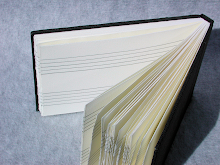




When I learned how to make mitered corners we learned a really involved and contorted way to do it. The corners were perfect, but it was very process intensive. I won't try to describe it. It finally occurred to me that there was a much easier way to do it with identical results. If anything the results are better considering how much less the book has to be handled. Less handling, less mess, fewer accidents. I since ran across this method in print but can't remember where. The sequence of photos are fairly clear. The only critical consideration is to use davey board that is the same thickness as what's being cover. The angle doesn't even have to be a perfect 45 degree angle, and the edges will still meet straight and flush.
Using mitered corners is not a necessity. Folded corners leave more cloth in the corners for wearability. The mitered corner is smoother and less bulky when that matters. The mitered corner is more durable than it may look, because the glue has a chance to impregnate the ends of the cloth fibers locking the edges together, and the end pages have a smooth, flush surface to adhere.









